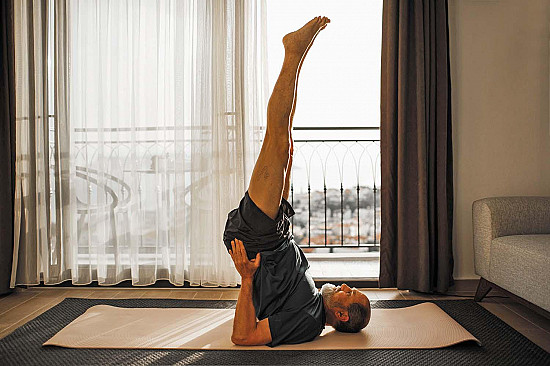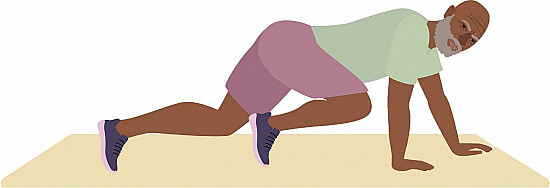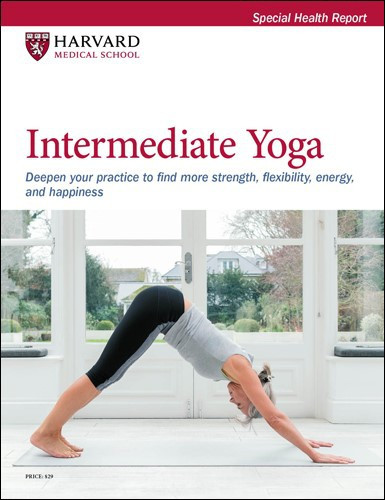More than a stretch: How yoga can enhance heart health
Beyond the physical benefits, yoga promotes mindful body awareness, which encourages healthy lifestyle changes.
- Reviewed by Christopher P. Cannon, MD, Editor in Chief, Harvard Heart Letter; Editorial Advisory Board Member, Harvard Health Publishing

If you’re trying to lose weight, you might assume that the best exercise strategy to achieve that goal is to do hard, sweaty workouts. But a gentler approach — a regular yoga practice — may help you shed pounds while also improving your cardiovascular health, according to a scientific review published in June 2025 in Current Trends in Cardiology.
The review looked at dozens of different studies that explored the impact of yoga on obesity-related measures and risk factors for cardiovascular disease. Over all, they show that yoga can decrease body mass index, waist circumference, and body fat percentage while also improving blood pressure and cholesterol values.
“Yoga is a form of low- to moderate-intensity aerobic exercise. But the postures also stretch and strengthen your core and other muscles,” says Dr. Gloria Yeh, director of mind-body research at Beth Israel Deaconess Medical Center and director of clinical research at the Osher Center for Integrative Health at Harvard Medical School. Each of these forms of physical activity burns calories, helps with fat loss while preserving muscle, and provides important physiological benefits that lower heart-related risks, she adds.
Mind-body benefits
Yoga isn’t just about moving your body. The practice also features breathing and meditation, both of which help cultivate mindful body awareness, says Dr. Yeh. Mindfulness — a state of full awareness of your thoughts, feelings, and experiences as they happen — can encourage and support healthier habits. For example, mindfulness-based interventions can help decrease stress eating (eating to soothe negative emotions rather than in response to hunger) and inspire people to make healthier food choices. Imaging studies show that mindfulness practices may strengthen brain cell connectivity in areas responsible for emotional regulation and impulse control.
Yoga also promotes activity of the parasympathetic (andamp;ldquo;rest and digest”) nervous system and lowers levels of the stress hormone cortisol. Both may improve metabolism and limit fat accumulation. Lower stress also means less bodywide inflammation, which likely contributes to yoga’s cardiovascular benefits.
Heart-centered yogaIn recent years, cardiac rehabilitation programs have begun incorporating yoga into their offerings. Research shows yoga can be a valuable addition to these programs, which feature customized education and exercise advice to help people recover from a heart attack, heart surgery, and related problems. Yoga of the Heart, a form of yoga designed for specifically for people with heart disease, is taught by instructors trained and certified by Nischala Joy Devi, who developed the yoga portion of the Dean Ornish Program for Reversing Heart Disease, an evidence-based, integrated lifestyle program for heart patients. Click the “teacher directory” tab at health.harvard.edu/hy to search for trained instructors near you. You can also inquire at hospital-based cardiac rehabilitation programs near you, as many may offer yoga-based programs. |
Finding your yoga fit
The myriad forms of yoga weave together three interconnected threads: physical postures (called asanas), controlled breathing, and relaxation and meditation to calm the mind. Many teachers incorporate a blend of different yoga styles. Two of the most popular forms taught in America, Hatha and Iyengar, are good choices for beginners.
Hatha yoga features gentle, slow, smooth movement, with a focus on integrating your breathing with the movements. Iyengar is similar but places more emphasis on body alignment and balance and uses props such as straps, blankets, and blocks. Another option is chair yoga, a gentle form of yoga practiced sitting in a chair or standing using a chair for support.
If you’re new to yoga, seek out a beginner or “gentle” class, especially if you’re over 65 or have any medical conditions, says Dr. Yeh. You can find classes at dedicated yoga studios as well as at health clubs and community or senior centers.
Many hospitals and medical centers now offer yoga classes geared toward people with chronic conditions; these are also often suitable for older, less active people, she adds. There are also classes specifically geared for people with larger bodies. Online classes can be a good option. If you have heart disease, see “Heart-centered yoga.”
“Find a friend to go with you so you can keep each other accountable and enjoy the class together,” Dr. Yeh suggests. For more about yoga from Harvard Health Publishing, see the box.
Image: © alvarez/Getty Images
About the Author

Julie Corliss, Executive Editor, Harvard Heart Letter
About the Reviewer

Christopher P. Cannon, MD, Editor in Chief, Harvard Heart Letter; Editorial Advisory Board Member, Harvard Health Publishing
Disclaimer:
As a service to our readers, Harvard Health Publishing provides access to our library of archived content. Please note the date of last review or update on all articles.
No content on this site, regardless of date, should ever be used as a substitute for direct medical advice from your doctor or other qualified clinician.
















